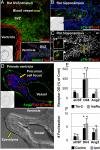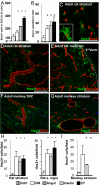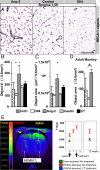Targeting neural precursors in the adult brain rescues injured dopamine neurons
- PMID: 19628689
- PMCID: PMC2714762
- DOI: 10.1073/pnas.0905125106
Targeting neural precursors in the adult brain rescues injured dopamine neurons
Abstract
In Parkinson's disease, multiple cell types in many brain regions are afflicted. As a consequence, a therapeutic strategy that activates a general neuroprotective response may be valuable. We have previously shown that Notch ligands support neural precursor cells in vitro and in vivo. Here we show that neural precursors express the angiopoietin receptor Tie2 and that injections of angiopoietin2 activate precursors in the adult brain. Signaling downstream of Tie2 and the Notch receptor regulate blood vessel formation. In the adult brain, angiopoietin2 and the Notch ligand Dll4 activate neural precursors with opposing effects on the density of blood vessels. A model of Parkinson's disease was used to show that angiopoietin2 and Dll4 rescue injured dopamine neurons with motor behavioral improvement. A combination of growth factors with little impact on the vasculature retains the ability to stimulate neural precursors and protect dopamine neurons. The cellular and pharmacological basis of the neuroprotective effects achieved by these single treatments merits further analysis.
Conflict of interest statement
The authors declare no conflicts of interest.
Figures




References
-
- Kim JH, et al. Dopamine neurons derived from embryonic stem cells function in an animal model of Parkinson's disease. Nature. 2002;418:50–56. - PubMed
-
- Roy NS, et al. Functional engraftment of human ES cell-derived dopaminergic neurons enriched by coculture with telomerase-immortalized midbrain astrocytes. Nat Med. 2006;12:1259–1268. - PubMed
-
- Freed CR, et al. Transplantation of embryonic dopamine neurons for severe Parkinson's disease. N Engl J Med. 2001;344:710–719. - PubMed
-
- Hagell P, et al. Dyskinesias following neural transplantation in Parkinson's disease. Nat Neurosci. 2002;5:627–628. - PubMed
Publication types
MeSH terms
Substances
Grants and funding
LinkOut - more resources
Full Text Sources
Other Literature Sources
Medical
Research Materials
Miscellaneous

